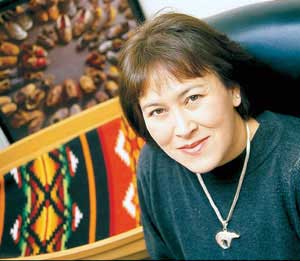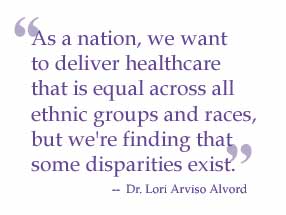|
|
For Release: June 1, 2005
Contact: Andy Nordhoff (603) 650-1492
American Indians and Alaska Native Veterans Have Higher Mortality Rate After Surgery than Caucasians, Study Finds
HANOVER, NH/WHITE RIVER JUNCTION, VT - Contributing to growing literature on marked racial and ethnic disparities in US healthcare, a study led by Dartmouth Medical School has concluded that American Indians and Alaska Natives have a greater chance of death within 30 days of surgery and suffer more from several preoperative risks compared to Caucasian patients.

Dr. Lori Arviso Alvord
Published in the June issue of the Journal of the American College of Surgeons (JACS), the Dartmouth Medical School-led study is the largest to explore surgical outcomes in the American Indian population. The study examined data on 4,419 male patients at Veterans Affairs (VA) hospitals across the country.
"As a nation, we want to deliver healthcare that is equal across all ethnic groups and races, but we're finding that some disparities exist," said lead author, Dr. Lori Arviso Alvord, assistant professor of surgery and of psychiatry at Dartmouth Medical School. "The results of this study add surgical outcomes to the list of health disparities experienced by Native Americans and offer further opportunities for investigation, intervention, and improvement in this understudied population."
Patients in the study were selected from the Veterans Affairs National Surgical Quality Improvement Program (NSQIP), an ongoing government-funded program that provides risk-adjusted surgical morbidity and mortality data to measure the quality of care at VA hospitals. A total of 2,155 American Indians and Alaska Natives in the NSQIP database who had surgery between 1991 and 2002 were matched by facility to an equal number of randomly selected Caucasian patients. Alvord and colleagues found a significant difference in mortality rates after surgery, with 3.1% of American Indians dying compared to 2.2% of Caucasian patients.

"We want to be sure that differences in the care American Indians receive is not the reason for this disparity," said Alvord, who has clinical appointments at Dartmouth-Hitchcock Medical Center and the VA Hospital in White River Junction, Vermont. "We will continue our research to explore factors that could lead to these variations and determine how they can be corrected," she said. The first Navajo woman surgeon in the U.S., Alvord notes that the health status of American Indians is generally lower than the total U.S. population, with a higher prevalence of diabetes and a shorter life expectancy.
The study also revealed higher rates of some preoperative risk factors among American Indians compared with Caucasians. These findings confirm previous reports that nearly twice as many older American Indians as Caucasians experience some type of functional impairment. The higher risk factors found in the study include wound infections, low platelet counts, and diabetes.
The JACS article cited related studies that found that American Indian patients received fewer kidney transplants than Caucasians and experienced a greater delay from onset of treated end-stage renal disease to transplantation. Another study found that the native population underwent coronary revascularization procedures less often than Caucasians. "Our results contribute to the growing literature on racial and ethnic health disparities in general, and in surgical outcomes in particular," the authors wrote in their conclusion.
Co-authors of the study include colleagues from the Native Elder Health Care Resource Center at the University of Colorado Health Sciences Center, the University of Washington, and Harvard Medical School. The study was supported by the Veterans Affairs National Surgical Quality Improvement Program and the National Institute on Aging Resource Centers for Minority Aging Research program.
-DMS-